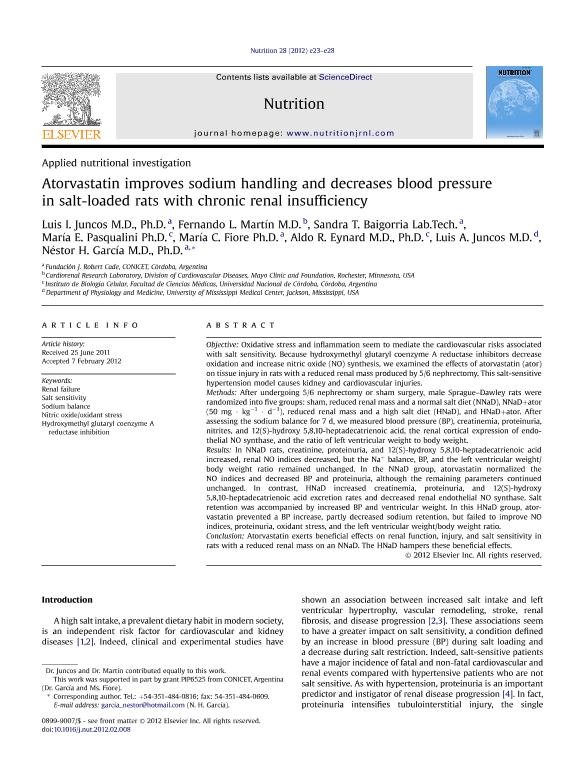Artículo
Atorvastatin improves sodium handling and decreases blood pressure in salt-loaded rats with chronic renal insufficiency
Juncos, Luis Isaias; Martín, Fernando L; Baigorria, Sandra T.; Pasqualini, María Eugenia; Fiore, María C.; Eynard, Aldo Renato ; Juncos, Luis A.; Garcia, Nestor Horacio
; Juncos, Luis A.; Garcia, Nestor Horacio
 ; Juncos, Luis A.; Garcia, Nestor Horacio
; Juncos, Luis A.; Garcia, Nestor Horacio
Fecha de publicación:
09/2012
Editorial:
Elsevier Science Inc
Revista:
Nutrition
ISSN:
0899-9007
Idioma:
Inglés
Tipo de recurso:
Artículo publicado
Clasificación temática:
Resumen
Oxidative stress and inflammation seem to mediate the cardiovascular risks associated with salt sensitivity. Because hydroxymethyl glutaryl coenzyme A reductase inhibitors decrease oxidation and increase nitric oxide (NO) synthesis, we examined the effects of atorvastatin (ator) on tissue injury in rats with a reduced renal mass produced by 5/6 nephrectomy. This salt-sensitive hypertension model causes kidney and cardiovascular injuries. Methods: After undergoing 5/6 nephrectomy or sham surgery, male Sprague-Dawley rats were randomized into five groups: sham, reduced renal mass and a normal salt diet (NNaD), NNaD+ator (50 mg · kg-1 · d-1), reduced renal mass and a high salt diet (HNaD), and HNaD+ator. After assessing the sodium balance for 7 d, we measured blood pressure (BP), creatinemia, proteinuria, nitrites, and 12(S)-hydroxy 5,8,10-heptadecatrienoic acid, the renal cortical expression of endothelial NO synthase, and the ratio of left ventricular weight to body weight. Results: In NNaD rats, creatinine, proteinuria, and 12(S)-hydroxy 5,8,10-heptadecatrienoic acid increased, renal NO indices decreased, but the Na+ balance, BP, and the left ventricular weight/body weight ratio remained unchanged. In the NNaD group, atorvastatin normalized the NO indices and decreased BP and proteinuria, although the remaining parameters continued unchanged. In contrast, HNaD increased creatinemia, proteinuria, and 12(S)-hydroxy 5,8,10-heptadecatrienoic acid excretion rates and decreased renal endothelial NO synthase. Salt retention was accompanied by increased BP and ventricular weight. In this HNaD group, atorvastatin prevented a BP increase, partly decreased sodium retention, but failed to improve NO indices, proteinuria, oxidant stress, and the left ventricular weight/body weight ratio. Atorvastatin exerts beneficial effects on renal function, injury, and salt sensitivity in rats with a reduced renal mass on an NNaD. The HNaD hampers these beneficial effects.
Archivos asociados
Licencia
Identificadores
Colecciones
Articulos(INICSA)
Articulos de INSTITUTO DE INVESTIGACIONES EN CIENCIAS DE LA SALUD
Articulos de INSTITUTO DE INVESTIGACIONES EN CIENCIAS DE LA SALUD
Citación
Juncos, Luis Isaias; Martín, Fernando L; Baigorria, Sandra T.; Pasqualini, María Eugenia; Fiore, María C.; et al.; Atorvastatin improves sodium handling and decreases blood pressure in salt-loaded rats with chronic renal insufficiency; Elsevier Science Inc; Nutrition; 28; 9; 9-2012; e23-e28
Compartir
Altmétricas



